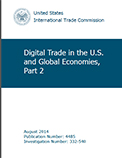
Digital trade -- domestic commerce and international trade conducted via the Internet -- has far-reaching effects on the U.S. economy that have fundamentally transformed many aspects of the ways businesses operate and interact with one another, reports the U.S. International Trade Commission (USITC) in its new publication.
Completed the report at the request of the U.S. Senate Committee on Finance, the report provides information on the value of U.S. digital trade and the potential growth of this trade, and it provides insight into the broader linkages and contributions of digital trade to the U.S. economy. The report includes a survey of U.S. firms in industries particularly involved in digital trade (digitally intensive firms), examines the effects of notable barriers and impediments to digital trade, and presents case studies that examine the importance of digital trade to selected U.S. industries. Report highlights follow.
- The combined effects of enhanced productivity and lower international trade costs in digitally intensive industries due to digital trade likely resulted in an estimated $517.1 billion to $710.7 billion increase (a 3.4 percent to 4.8 percent increase) in U.S. gross domestic product (GDP). U.S. real wages were likely higher by 4.5 percent to 5.0 percent, and the effect on U.S. total employment ranged from no change to an increase of 2.4 million full-time equivalents (FTEs), depending on how workers and employers responded to rising wages. If the effects of enhanced productivity and lower trade costs in non-digitally intensive sectors were also quantified, the economy-wide estimates would likely be larger. [Read More]
- U.S. digitally intensive firms sold $935.2 billion in products and services and purchased $471.4 billion in products and services over the Internet. Most products and services firms sold or purchased online in 2012 were delivered physically or in person -- not digitally. [Read More]
- Online sales by digitally intensive small and medium-sized enterprises (SMEs) were $227.1 billion, or about one-fourth of total online sales, and online purchases by SMEs were $162.2 billion, or about one-third of total online purchases. Sales and purchases by both SMEs and large firms are more likely to have been delivered physically or in person than digitally delivered. [Read More]
- The Commission's survey of U.S. digitally intensive firms found that internal communications and online ordering of products and services are the leading ways firms use the Internet. [Read More]
- Survey estimates also showed that losing access to the Internet would reduce productivity by 15 percent or more for more than 40 percent of firms in digitally intensive industries. Business-to-business communications ranked as the largest contributor to the productivity benefits of the Internet; selling online products or services was tied with ordering online products or services as the second largest. [Read More]
- Online international trade is a relatively small component of U.S. exports and imports of both digitally and physically delivered products and services. Digitally intensive firms exported $222.9 billion and imported $106.2 billion in products and services ordered online in 2012. Most exports and imports ordered online are delivered physically or in person -- not digitally. [Read More]
- Localization requirements, market access limits, data privacy and protection requirements, intellectual property rights infringement, uncertain legal liability rules, and customs measures in other countries present obstacles to international digital trade by U.S. digitally intensive firms. According to survey results, the removal of foreign barriers to digital trade would boost U.S. sales abroad, although not all sectors would benefit equally. [Read More]
- The removal of foreign barriers to digital trade in digitally intensive industries would likely result in an estimated $16.7 billion to $41.4 billion increase (a 0.1 percent to 0.3 percent increase) in U.S. GDP. U.S. real wages would likely be 0.7 percent to 1.4 percent higher, and the effect on U.S. total employment would range from no change to an increase of 0.4 million FTEs. [Read More]
- The report features 10 case studies that highlight the importance of digital trade to selected U.S. businesses. They describe how Internet-based economic activity has created new or improved business opportunities, and sometimes disrupted older business models; how companies and consumers use the massive amounts of data currently available over the Internet to develop innovative products and services and to enhance productivity; and the impact of the Internet and international digital trade on global competitiveness, including from the perspective of SMEs. [Read More]
- The report is the second of two requested by the Committee. The first report, Digital Trade in the U.S. and Global Economies, Part 1, was delivered in July 2013. That report laid the groundwork for the second report by providing an overview of trends in U.S. digital trade, describing the ways digital trade facilitates trade in other sectors, and setting out potential approaches for estimating the economic impact of digital trade on the U.S. economy. The first report also examined available information on international digital trade, including notable barriers and impediments to such trade.
View the publication at: http://www.usitc.gov/publications/332/pub4485.pdf


















